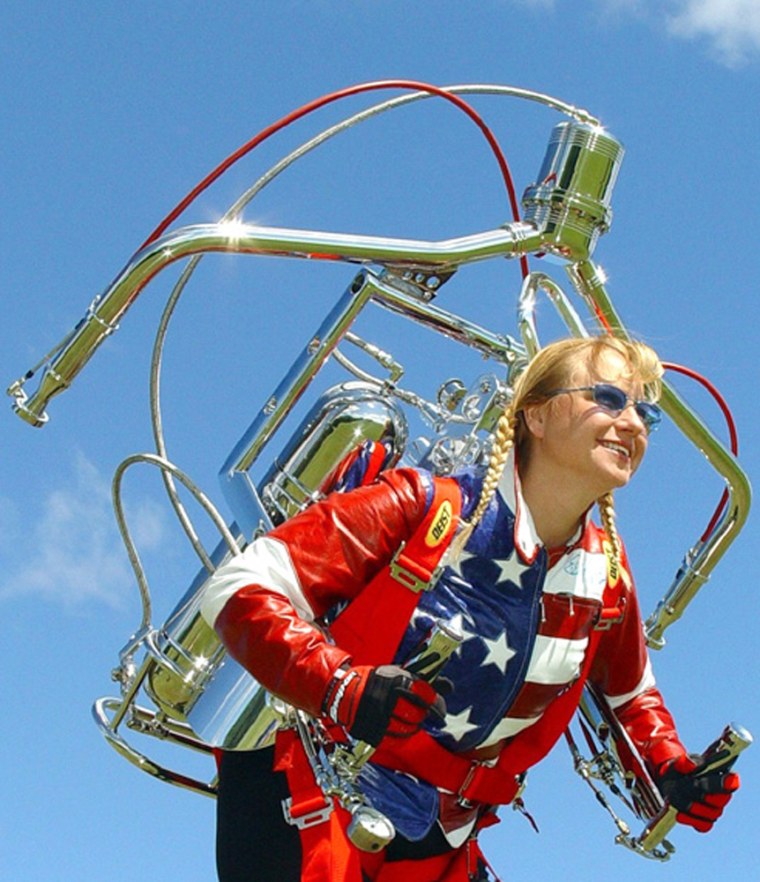Let’s face it. Soaring through the sky in Superman-like style would be a Cloud 9-rated experience. Imagine propelling yourself from point-to-point via backpacking rocket power.
For a group of test pilots, riding rocketbelt hardware is a trip down memory lane — back to the late 1950’s and bounding forward into the 1960’s.
Back then, a working jetpack was designed and built by Bell Aerospace — now Textron Systems — and was originally designed and partially funded as prototype equipment for the U.S. Army. The Bell rocketbelt worked by releasing high-pressure nitrogen gas through nozzles. The pack, developed by Bell engineer Wendell Moore, could propel a person into the air for 20 seconds. The belt and one of the firm’s test pilots, Bill Suitor, toured the world in the late 1960s, but corporate-backing of the apparatus eventually waned.
Movie-goers might recall seeing a working jetpack in the 1965 James Bond film, Thunderball. Then there was that 1991 movie, The Rocketeer, where the hero blasts about using a portable rocket backpack to stay one hop ahead of a technology-hungry Nazis.
Next month, for the first time in public, members of the original Bell Aerospace rocketbelt team are meeting modern day rocketbelt engineers, builders, and pilots from around the world — enthusiasts that are keen on keeping the dream alive and high-flying.
Preserving the legacy
A rocketbelt convention is being held September 23-24 at the Niagara Aerospace Museum in Niagara Falls, New York, culminating in an all-up demonstration flight. The program is sponsored by Jet P.I./GoFast energydrinks.
“The convention will be a unique, one of a kind, never seen before event,” said convention co-organizer, Peter Gijsberts of Nuenen, the Netherlands and head of the Airwalker Society that has preserved the legacy and the historical data of rocketbelt flights.
“We’ll have Bell test pilots, the original rocketbelts, modern rocketbelts and the pilots, memorabilia, lecturers, and, of course, a real rocketbelt demonstration,” Gijsberts told SPACE.com.
Why all the fanfare?
“I think the desire to fly is intrinsic, timeless, and universal,” said Kathleen Lennon Clough, co-organizer of the rocketbelt convention. She is the daughter of Tom Lennon, Bell’s senior photographer and cinematographer back then who not only chronicled the rocketbelt’s development but flew the device too.
“How powerful would I feel if I could quickly rescue someone who was in danger,” Clough said, “or get supplies to where they were needed in time? Who doesn’t want to be a super-hero?”
NASA interest
There was a time when rocketbelt magic and derivative schemes caught the eye of NASA.
The rocketbelt concept led directly to the first manned maneuvering unit pioneered for the Gemini program and later in Skylab, said Barry DiGregorio, a science writer, rocketbelt aficionado, as well as a research associate for the Cardiff Centre for Astrobiology in Wales.
“In the 1960’s the rocketbelt was modified and almost used by NASA on Apollo
for exploration of the lunar surface … and even as a lunar rescue vehicle had the lunar module ascent engine failed to ignite,” DiGregorio told SPACE.com. “In the low gravity environment of the Moon the astronauts could have simply unstowed their rocket belts and rendezvoused with the command module waiting in lunar orbit. NASA opted for the lunar rover car instead, trusting that the lunar module ascent engine would not fail … a risky gamble.”
Yet the future of the jet belt depends on replacing the heavy hydrogen peroxide fuel tank system with something more efficient to extend the flight time, DiGregorio said, “perhaps using ducted fans or small jet engines. The potential to use the rocketbelt/jet belt for rescue in high rise fires or other natural disasters needs to be explored. For sports flying enthusiasts it would be the ultimate flying machine…flight without wings!”
Flying rocket chair
Taking part in next month’s convention is rocketman Ky Michaelson. He has been busy at work for several years on rocketbelt designs.
“I decided to show the world that you could easily build a rocketbelt for less then the cost of a nice motorcycle. That was my first goal. My other goal was to fly one foot off the ground … and I would be happy guy,” Michaelson told SPACE.com.
Michaelson said he’s focused on a flying rocket chair, not only able to carry more peroxide for a longer flight time, but also easier to fly.
“I predict that some day there will be people racing rocket belts just like air races,” Michaelson explained. “But I also predict that if there are 10 rocket belts flying at least four people will be killed or seriously injured. I hope I am wrong. But these things are incredibly dangerous,” he said.
Hydrogen peroxide rockets are simple, Michaelson added. “I have never seen one that didn’t work. I have had over 700 firings of hydrogen peroxide rockets … but if you are not careful, either the vehicle will get you or the fuel will.”
Air rage
But the rocketbelt as mainstream flying machine in the future does not appear to be in the cards, enthusiasts said.
“If you think gas is expensive, try peroxide! Plus, the mileage is worse than a Hummer or a Ferrari,” Clough told SPACE.com. “And where can you get to in 30 seconds, especially when you have to descend in time so you don’t crash.”
There is the issue of local noise ordinances, Clough added. “Then think of the
problem of driving under the influence: DUI in the air with rockets on our backs. Or air rage?” For the average person, Clough said, the fantasy of rocketbelt flying is better than the reality.
“For most of us, the juice isn’t worth the squeeze. Generally speaking, I think building a flying rocketbelt is a ‘guy thing’…but you have to be a really smart guy, like a rocket scientist, in good shape, with good balance and a lot of money. That is not the mainstream,” Clough concluded.
